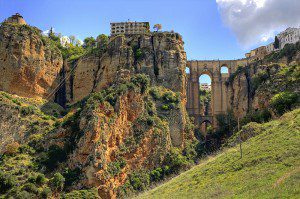
Wikimedia Commons; click to enlarge
It was fun yesterday, traveling from Istanbul to Málaga, to fly over Tunisia and Algeria — two countries where I’ve never yet set foot.
My wife and I met two of our neighbors there and, after settling in at the place where we’re staying, had an excellent meal of sea bass with them at a little restaurant directly on the Mediterranean.
But how, you may ask, can Peterson be doing this? Is he siphoning funds from the Interpreter Foundation in order to finance his self-serving junkets? (Answer: No, he’s not.) Doesn’t he have a job? Shouldn’t he be teaching classes?
Right now, I know that some of my critics are likely hyperventilating with rage at this trip to Spain and at the various crimes and acts of dishonesty and malfeasance that I surely must have committed in order to be here. Mine, you see, is a life built upon hatred and lies.
I came to Europe late last week in order to participate in the G20 Interfaith Summit. Having participated in those meetings through late Wednesday night, I had already missed my classes for this week. How? They’re all crammed into Tuesdays and Thursdays, and I couldn’t possibly have returned to Provo in time to have taught my Thursday classes. (Fortunately, my generous friend, former student, and current Interpreter Foundation colleague Andrew Smith — who pretty much got our series of Interpreter roundtable discussions on a solid footing — is covering them for me.) And, this next week, I have no classes to teach — since Thursday is Thanksgiving Day and since BYU, in its academic-calendrical wisdom, has decreed that Tuesday shall be a “Friday” for purposes of classroom instruction.
Anyhow, figuring that I’m already in the eastern hemisphere and that I have no compelling reason to come home right away, I’m here, with wife and friends, looking at sites in Spain. And, if that irritates some of my more monotonously irascible critics, that’s perfectly fine with me. They seem to enjoy it.
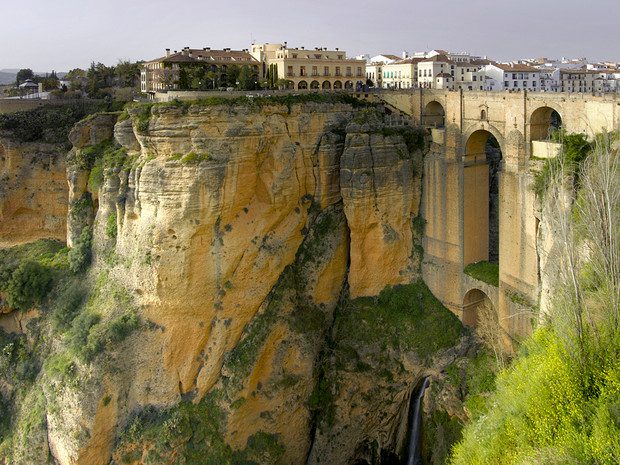
(Wikimedia Commons)
We spent today in the Andalusian mountain town of Ronda, which was founded by Celtic settlers in the sixth century BC. In AD 713, Arab forces took it from the Visigoths, and it remained an Arab city for nearly eight centuries — until its last Arab ruler was forced to surrender it in 1485. (The Reconquista was successful throughout the Iberian Peninsula by 1492, so Ronda held out until very near the end.) Its principal mosque was seized and converted upon the conquest into the church of Santa María la Mayor. We visited that church today; the mosque’s mihrab is still plainly visible at the back of the main altar.
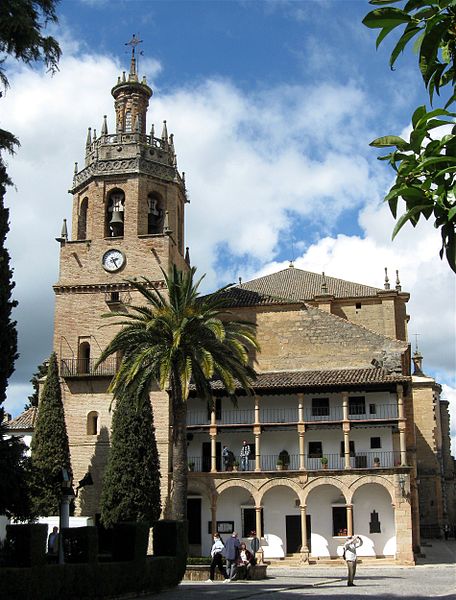
Its bell tower represents a transformation and repurposing of what was originally the minaret of Ronda’s principal mosque.
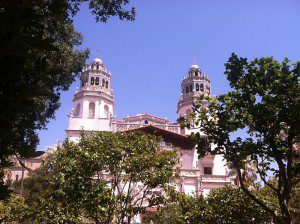
(Wikimedia Commons; click to enlarge)
One of the buildings directly adjacent to the Ronda’s Puente Nuevo or “New Bridge” was a headquarters for the Spanish Inquisition. Its location wasn’t coincidental:
Shortly after 1492, when Granada, the very last outpost of Muslim sovereignty in Iberia was conquered, the Spanish decreed that all Muslims must either convert to Christianity or depart from the peninsula, leaving their belongings behind. Many Muslims — these came to be known as “Moriscos” — secretly retained and practiced their faith, but converted outwardly in order to keep their possessions and remain in their homes. They were required to wear a blue crescent upon their caps and turbans, and they were subject to the death penalty if they were caught traveling without a permit. This systematic suppression forced Muslims to seek refuge in mountainous regions of southern Andalusia; Ronda was one such place of refuge. In the second half of the 1500s, though, Philip II leveled heavy taxes on the trades dominated by Moriscos, banned the use of Arabic in either speaking or writing, and ordered that doors in private dwellings remain open on Fridays so that officials could ensure that no secret Muslim prayers were going on. This led to several rebellions, including a rather successful one in Ronda. In the end, though, all Moriscos were expelled from the town.
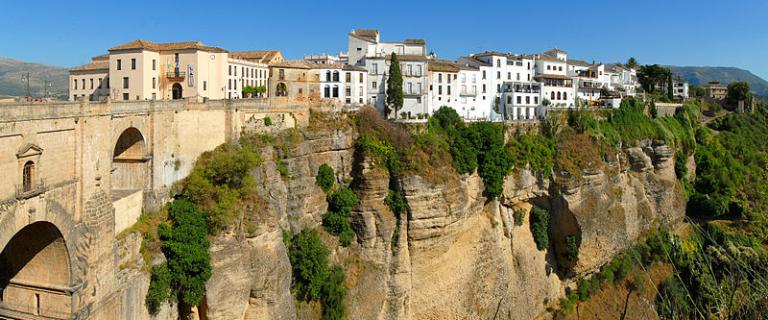
(Wikimedia CC)
“I have looked everywhere for the city of my dreams,” wrote the great Austrian poet Rainer Maria Rilke, “and have finally found it in Ronda.” “The whole city and its surroundings form a perfect romantic setting,” remarked Ernest Hemingway, who loved to attend bullfights in its Plaza de Toros, which is arguably the birthplace of modern Spanish bullfighting.
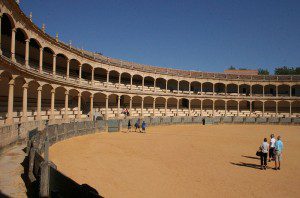
(Wikimedia Commons; click to enlarge)
The famous scene in the tenth chapter of Hemingway’s novel For Whom the Bell Tolls, which describes the execution of Fascist sympathisers in a (fictional) village during the Spanish Civil War — they’re thrown off a cliff — may have been modeled on an actual 1936 event in Ronda.
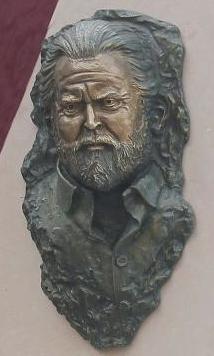
From the monument in Ronda
(Wikimedia Commons)
Just outside the Plaza de Toros stand two sculptured monuments, each eight feet tall — one of them to Hemingway and the other to the late great actor and filmmaker Orson Welles. The inscription on the latter is a quotation from Orson Welles that reads “A man is not from where he was born but where he chooses to die.” His ashes are buried in Ronda, on property belonging to his close friend, the late matador Antonio Ordoñez, who is himself a legend in Spain.
Posted from Marbella, Spain











